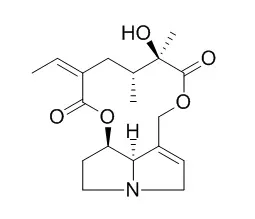| Description: |
Senecionine (SEN) is a representative of the hepatotoxic pyrrolizidine alkaloids.
|
| Targets: |
P450 (e.g. CYP17) | Calcium Channel |
| In vitro: |
| Biochem Pharmacol. 1989 Feb 1;38(3):391-7. | | Effects of the pyrrolizidine alkaloid senecionine and the alkenals trans-4-OH-hexenal and trans-2-hexenal on intracellular calcium compartmentation in isolated hepatocytes.[Pubmed: 2492804] | The pyrrolizidine alkaloid Senecionine has been shown to produce an increase in cytosolic free Ca2+ concentration in isolated hepatocytes that correlated with an increase in cellular toxicity.
METHODS AND RESULTS:
The cytotoxicity was greater in the absence of extracellular Ca2+ than in its presence, suggesting that alterations in intracellular Ca2+ distribution, and not an influx of extracellular Ca2+, were responsible for the Senecionine-induced hepatotoxicity. The effect of Senecionine, as well as the effects of trans-4-OH-2-hexenal (t-4HH), a microsomal metabolite of Senecionine, and a related alkenal, trans-2-hexenal, on the sequestration of Ca2+ in mitochondrial and extramitochondrial compartments were examined in isolated hepatocytes. Each of the test compounds elicited a decrease in the available extramitochondrial Ca2+ stores that was inhibited by pretreatment with the thiol group reducing agent, dithiothreitol. Senecionine and t-4HH decreased the level of Ca2+ sequestered in the mitochondrial compartment of hepatocytes. The presence of a pyridine nucleotide reducing agent, beta-hydroxybutyrate, inhibited this reduction.
CONCLUSIONS:
These results suggest that both Senecionine and t-4HH inhibit the sequestration of Ca2+ in extramitochondrial and mitochondrial compartments possibly by inactivating free sulfhydryl groups and oxidizing pyridine nucleotides respectively. |
|
| In vivo: |
| Chem Res Toxicol. 2014 May 19;27(5):775-86. | | Metabolomic and genomic evidence for compromised bile acid homeostasis by senecionine, a hepatotoxic pyrrolizidine alkaloid.[Pubmed: 24641316] |
METHODS AND RESULTS:
Senecionine hepatotoxicity on rats was determined via a combination of metabolomic and genomic analyses. From the global analysis generated from two omics data, the compromised bile acid homeostasis in vivo was innovatively demonstrated and confirmed. Serum profiling of bile acids was altered with significantly elevated conjugated bile acids after Senecionine exposure, which was in accordance with toxicity. Similarly, the hepatic mRNA levels of several key genes associated with bile acid metabolism were significantly changed.
CONCLUSIONS:
In conclusion, a cross-omics study provides a comprehensive analysis method for studying the toxicity caused by Senecionine, which is a hepatotoxic PA. Moreover, the change in bile acid metabolism and the respective transporters may provide a new PA toxicity mechanism. | | Carcinogenesis. 1991 Mar;12(3):515-9. | | Role of cytochrome P450IIIA4 in the metabolism of the pyrrolizidine alkaloid senecionine in human liver.[Pubmed: 2009596] | Studies were carried out to investigate the metabolism of Senecionine by human liver microsomes and the role of human cytochrome P450IIIA4 in this process.
METHODS AND RESULTS:
Human liver microsomes metabolized Senecionine to two major products, (+/-)-6,7-dihydro-7-hydroxy-1-hydroxymethyl-5H-pyrrolizine (DHP) and Senecionine N-oxide. The rates of product formation (DHP and Senecionine N-oxide) varied widely with the microsomal samples tested. There was a 30-fold difference in DHP formation and a 25-fold difference in N-oxidation between the poorest metabolizer and the highest metabolizer of Senecionine. The conversion of Senecionine to DHP and Senecionine N-oxide in human liver microsomes was markedly inhibited by the mechanism-based inactivators of P450IIIA4, gestodene and triacetyloleandomycin. Anti-P450IIIA4 IgG, at a concentration of 1 mg/nmol of P450, was found to inhibit completely the formation of DHP and Senecionine N-oxide in human liver microsomes (HL101) having low activity toward Senecionine. At 5 mg IgG/nmol P450, anti-P450IIIA4 inhibited 90 and 84% respectively of the formation of DHP and Senecionine N-oxide in liver microsomes (HL110) with the highest activity toward Senecionine. The formation of DHP or Senecionine N-oxide was highly correlated with the amount of P450IIIA4 measured in the microsomes using polyclonal anti-P450IIIA4 IgG. The rate of DHP production also had a strong correlation with the rate of Senecionine N-oxide formation (r = 0.999) and with the rate of nifedipine oxidation (r = 0.998).
CONCLUSIONS:
Our present studies provide evidence that P450IIIA4 is the major enzyme catalyzing the bioactivation (DHP formation) and detoxication (Senecionine N-oxide formation) of Senecionine in human liver. |
|






 Cell. 2018 Jan 11;172(1-2):249-261.e12. doi: 10.1016/j.cell.2017.12.019.IF=36.216(2019)
Cell. 2018 Jan 11;172(1-2):249-261.e12. doi: 10.1016/j.cell.2017.12.019.IF=36.216(2019) Cell Metab. 2020 Mar 3;31(3):534-548.e5. doi: 10.1016/j.cmet.2020.01.002.IF=22.415(2019)
Cell Metab. 2020 Mar 3;31(3):534-548.e5. doi: 10.1016/j.cmet.2020.01.002.IF=22.415(2019) Mol Cell. 2017 Nov 16;68(4):673-685.e6. doi: 10.1016/j.molcel.2017.10.022.IF=14.548(2019)
Mol Cell. 2017 Nov 16;68(4):673-685.e6. doi: 10.1016/j.molcel.2017.10.022.IF=14.548(2019)